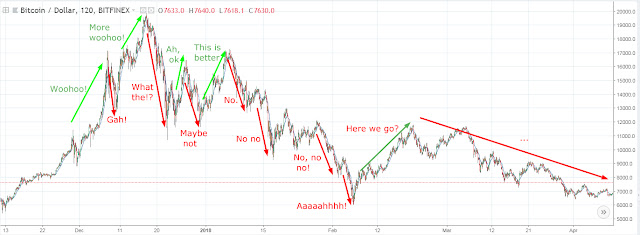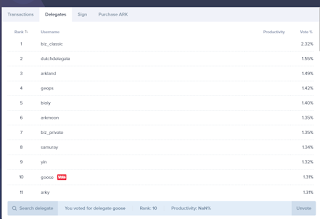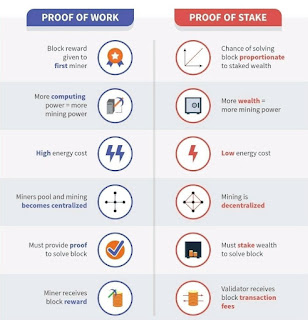Crypto Tales Part 3 - The Crash of '18
In mid-December of the year two thousand and seventeen, Bitcoin hit an all-time high, reaching a valuation of nearly $20,000 per coin! It dipped heavily afterwards, but seemed to recover over the next couple of weeks. I took the opportunity to diversify into numerous Altcoins during the slump, and was rewarded as they all rode the waves upwards, many hitting their all-time highs in early January.
Then, all the markets began to crumble.
None can say for sure what caused this crash (aside from, "it was due" -- though it should also be noted that there was a large crash in the stock market at the same time), but there was certainly plenty of bad news going around to help foster a generally negative sentiment towards Cryptocurrency
Bitconnect, a somewhat popular trading platform closed shop after being filed with cease-and-desist letters from two different U.S. state governments. Warren Buffet, a respected guru of financial wisdom in the US, decried Bitcoin and the entire Cryptocurrency space (though he did also admit that he knew nothing about it -- but that was never mentioned in the news headlines). Rumors came that both South Korea and China were going to crackdown on Cryptocurrency. Facebook and Google banned advertisements for Crytpocurrency (Bing would later follow suit, though I don't think many noticed).
On the more ludicrous side of things. Venezuala tried to circumvent sanctions by creating a cryptocurrency, which their own citizens didn't want, even though it was free! And Kodak also announced their own cryptocurrency. The idea of an old-school camera company creating a blockchain network was roundly scoffed at, but nonetheless the announcement alone resulted in Kodak's stock price increasing by 156%!), which is a bit insane.
These are just a few. There were plenty of other wacky stories, from hacks/viruses that used other people's computers to mine Cryptocurrency, to a Floyd Mayweather endorsed ICO (Initial Coin Offering), being declared a fraud.
But one of the more intriguing occurrences in the first quarter of 2018 arose with a small, Italian Cryptocurrency exchange called Bitgrail.
====================
In early February of 2018, Bitgrail declared insolvency, stating that they 17 million units of a Cryptocurrency called Nano were missing from their exchange. This was particularly troubling because most of the exchange's popularity was due to the fact that they were one of the first to make trading available for the NANO token.
In leaked conversations, it was revealed that, Francesco Firano, the dev/owner of Bitgrail, reached out to the NANO developers, suggesting that they had a bug in their code and requesting that they 'fix' the issue by creating a hard fork to refund the stolen coins.
While this might seem like a normal financial request, 'someone stole my funds -- please reverse the transactions', it touches upon an interesting part of the whole Blockchain concept, which is that of an Immutable Ledger. The idea behind an Immutable Ledger is that it's a transaction ledger which is, well... immutable, meaning that its history cannot be altered. Once a transaction is recorded onto the blockchain, that transaction is permanent.
A blockchain is a series of groups of transactions (blocks) that are linked together. Each block of transactions is compressed down to a cryptographic hash key which is then included in the next transaction block, and so on, ad infinitum, making it nearly impossible for any group or individual to alter the transaction history.
So, knowing that a Blockchain is meant to be a ledger written with permanent ink, why would the Bitgrail owner even try to make such a request? Probably because a precedent had been set for such rollbacks with Ethereum just a couple of years prior.
----
In June of 2016, there was a hack against an Ethereum based investment fund called DAO. The hackers made off with 3.6 million Ether coins (worth ~$70 million at the time). This was a huge blow to the community as those funds were slated to be used for investment into developers creating Distributed Apps on the Ethereum Network, the bolstering the network's entire ecosystem.
It was determined that there was a code flaw in the smart contracts that allowed the hack to happen, and a proposal was submitted for a code change that would allow the the stolen coins to be returned to DAO. In a normal code development cycle, the team who owns the code would decide what code changes to make. But in the case of decentralized networks such as Ethereum and Bitcoin, they have a concept called Consensus. Consensus is basically a method of getting all of the network nodes to agree on a thing, in this case, a code change. Once 51% of the weight of all the nodes (different infrastructures have different methods of determining how much voting power everyone is assigned) agree on that thing, then that thing becomes truth on that network. If the network does not adopt the change, then it is rejected. And sometimes, you can have a network split.
A dissenting portion of the network nodes can decide to break off, and form their own network, based off of the transactional chain from the original network and maintaining all of those original records. So both networks will have the exact same blockchain, up to a point. But at the point of the split, the codebases will differ and you now have two separate coins were there once was one
In the case of the proposed code change for the DAO hack, Consensus was reached with a super-majority of 89% voting for the update. A minority disagreed with the code change, arguing that such transaction reversals went against the very nature of the Blockchain technology and destroyed the ideal of an Immutable Ledger. The dissenters decided to not adopt the code change, instead continuing onward, branching off into a new coin called Ethereum Classic, which, while not nearly as popular as Ethereum, is still maintaining its own network.
But I digress a bit. The main point is that a precedent had been set (even though it was quite contentious) within the Cryptocurrency community for the possibility of a special code change that would allow the returning of stolen funds.
----
So it is perhaps with this past event in mind that Francesco made his request. Unfortunately for him, the Nano devs were a bit reluctant to make such a change, especially once they realized that the missing funds were not due to an issue with the Nano currency itself, but rather related to some sort of coding error on the exchange's site which resulted in double (sometimes triple) credited deposits which could then be withdrawn.
Things went downhill form there for Bitgrail as it emerged that irregularities had been occurring (and reported) as far back as December. They filed for bankruptcy soon after and I believe are also currently facing numerous civil suits. I'm not sure that we really know the full story yet (and perhaps never will), but here are a couple of detailed breakdowns if you are interested in further reading on the subject.
====================
During all of this Cryptocurrency zaniness, I invested more during the dips when I felt bold, and was often rewarded with a two or three day upward trend in the market soon after. But the Bull markets were short-lived, and the falls afterwards deep.
The Altcoin market was hit especially hard. The entire Cryptocurrency market is very tied to Bitcoin (though that is slowly starting to change), and if Bitcoin dropped 10%, the Altcoins would often fall by 20% over the same period. My gains in December and January were quickly erased. And some of the coins that I bought in early January took a legendary beating. Once coin, in particular, VIBE, lost 75% of its value over the next few months.
Bitcoin hit bottom around $6000 in early February, and after a brief return over $10,000, slid steadily downward through April. Long before then I had already reached the end of the money I could potentially invest as I had quit my job at the end of January (not because I expected to be Crypto-millionaire, though that would have been nice), and didn't yet have any additional income. The Bear market was holding my portfolio in the red, and being too much of a novice to have known when to sell, and lacking any additional fiat to try and invest in the suppressed coin values, there wasn't much for me to do actively with the markets, aside from obsessively check the news and prices, hoping for a godsend.
I did end up shifting funds around, moving most of my Bitcoin into other coins, figuring that those would have more potential for gains when the markets turned back around. But, I also discovered that there were other avenues I could explore within the Cryptocurrency space. In addition to the more well-known mining option, there was also staking, airdrops, bounties, master nodes, and the supposed monetization of your stuff, such as personal data, what videos you watch, and even your genetic information!
It was time to branch out, dig a little deeper into this tech and see what I could find.
Next up... Catching Airdrops
Then, all the markets began to crumble.
 |
| Bitcoin prices in late 2017/early 2018 |
None can say for sure what caused this crash (aside from, "it was due" -- though it should also be noted that there was a large crash in the stock market at the same time), but there was certainly plenty of bad news going around to help foster a generally negative sentiment towards Cryptocurrency
Bitconnect, a somewhat popular trading platform closed shop after being filed with cease-and-desist letters from two different U.S. state governments. Warren Buffet, a respected guru of financial wisdom in the US, decried Bitcoin and the entire Cryptocurrency space (though he did also admit that he knew nothing about it -- but that was never mentioned in the news headlines). Rumors came that both South Korea and China were going to crackdown on Cryptocurrency. Facebook and Google banned advertisements for Crytpocurrency (Bing would later follow suit, though I don't think many noticed).
On the more ludicrous side of things. Venezuala tried to circumvent sanctions by creating a cryptocurrency, which their own citizens didn't want, even though it was free! And Kodak also announced their own cryptocurrency. The idea of an old-school camera company creating a blockchain network was roundly scoffed at, but nonetheless the announcement alone resulted in Kodak's stock price increasing by 156%!), which is a bit insane.
These are just a few. There were plenty of other wacky stories, from hacks/viruses that used other people's computers to mine Cryptocurrency, to a Floyd Mayweather endorsed ICO (Initial Coin Offering), being declared a fraud.
But one of the more intriguing occurrences in the first quarter of 2018 arose with a small, Italian Cryptocurrency exchange called Bitgrail.
====================
 |
| Nano symbol |
In leaked conversations, it was revealed that, Francesco Firano, the dev/owner of Bitgrail, reached out to the NANO developers, suggesting that they had a bug in their code and requesting that they 'fix' the issue by creating a hard fork to refund the stolen coins.
While this might seem like a normal financial request, 'someone stole my funds -- please reverse the transactions', it touches upon an interesting part of the whole Blockchain concept, which is that of an Immutable Ledger. The idea behind an Immutable Ledger is that it's a transaction ledger which is, well... immutable, meaning that its history cannot be altered. Once a transaction is recorded onto the blockchain, that transaction is permanent.
A blockchain is a series of groups of transactions (blocks) that are linked together. Each block of transactions is compressed down to a cryptographic hash key which is then included in the next transaction block, and so on, ad infinitum, making it nearly impossible for any group or individual to alter the transaction history.
So, knowing that a Blockchain is meant to be a ledger written with permanent ink, why would the Bitgrail owner even try to make such a request? Probably because a precedent had been set for such rollbacks with Ethereum just a couple of years prior.
----
In June of 2016, there was a hack against an Ethereum based investment fund called DAO. The hackers made off with 3.6 million Ether coins (worth ~$70 million at the time). This was a huge blow to the community as those funds were slated to be used for investment into developers creating Distributed Apps on the Ethereum Network, the bolstering the network's entire ecosystem.
It was determined that there was a code flaw in the smart contracts that allowed the hack to happen, and a proposal was submitted for a code change that would allow the the stolen coins to be returned to DAO. In a normal code development cycle, the team who owns the code would decide what code changes to make. But in the case of decentralized networks such as Ethereum and Bitcoin, they have a concept called Consensus. Consensus is basically a method of getting all of the network nodes to agree on a thing, in this case, a code change. Once 51% of the weight of all the nodes (different infrastructures have different methods of determining how much voting power everyone is assigned) agree on that thing, then that thing becomes truth on that network. If the network does not adopt the change, then it is rejected. And sometimes, you can have a network split.
A dissenting portion of the network nodes can decide to break off, and form their own network, based off of the transactional chain from the original network and maintaining all of those original records. So both networks will have the exact same blockchain, up to a point. But at the point of the split, the codebases will differ and you now have two separate coins were there once was one
In the case of the proposed code change for the DAO hack, Consensus was reached with a super-majority of 89% voting for the update. A minority disagreed with the code change, arguing that such transaction reversals went against the very nature of the Blockchain technology and destroyed the ideal of an Immutable Ledger. The dissenters decided to not adopt the code change, instead continuing onward, branching off into a new coin called Ethereum Classic, which, while not nearly as popular as Ethereum, is still maintaining its own network.
But I digress a bit. The main point is that a precedent had been set (even though it was quite contentious) within the Cryptocurrency community for the possibility of a special code change that would allow the returning of stolen funds.
----
So it is perhaps with this past event in mind that Francesco made his request. Unfortunately for him, the Nano devs were a bit reluctant to make such a change, especially once they realized that the missing funds were not due to an issue with the Nano currency itself, but rather related to some sort of coding error on the exchange's site which resulted in double (sometimes triple) credited deposits which could then be withdrawn.
Things went downhill form there for Bitgrail as it emerged that irregularities had been occurring (and reported) as far back as December. They filed for bankruptcy soon after and I believe are also currently facing numerous civil suits. I'm not sure that we really know the full story yet (and perhaps never will), but here are a couple of detailed breakdowns if you are interested in further reading on the subject.
====================
During all of this Cryptocurrency zaniness, I invested more during the dips when I felt bold, and was often rewarded with a two or three day upward trend in the market soon after. But the Bull markets were short-lived, and the falls afterwards deep.
The Altcoin market was hit especially hard. The entire Cryptocurrency market is very tied to Bitcoin (though that is slowly starting to change), and if Bitcoin dropped 10%, the Altcoins would often fall by 20% over the same period. My gains in December and January were quickly erased. And some of the coins that I bought in early January took a legendary beating. Once coin, in particular, VIBE, lost 75% of its value over the next few months.
Bitcoin hit bottom around $6000 in early February, and after a brief return over $10,000, slid steadily downward through April. Long before then I had already reached the end of the money I could potentially invest as I had quit my job at the end of January (not because I expected to be Crypto-millionaire, though that would have been nice), and didn't yet have any additional income. The Bear market was holding my portfolio in the red, and being too much of a novice to have known when to sell, and lacking any additional fiat to try and invest in the suppressed coin values, there wasn't much for me to do actively with the markets, aside from obsessively check the news and prices, hoping for a godsend.
I did end up shifting funds around, moving most of my Bitcoin into other coins, figuring that those would have more potential for gains when the markets turned back around. But, I also discovered that there were other avenues I could explore within the Cryptocurrency space. In addition to the more well-known mining option, there was also staking, airdrops, bounties, master nodes, and the supposed monetization of your stuff, such as personal data, what videos you watch, and even your genetic information!
It was time to branch out, dig a little deeper into this tech and see what I could find.
Next up... Catching Airdrops




Nice synopsis, I'm hoping ripple and its forks make headway into stabilizing the industry. Also look into the Winklevoss Facebook twins and their FDIC backed coin exchange Gemini.
ReplyDelete